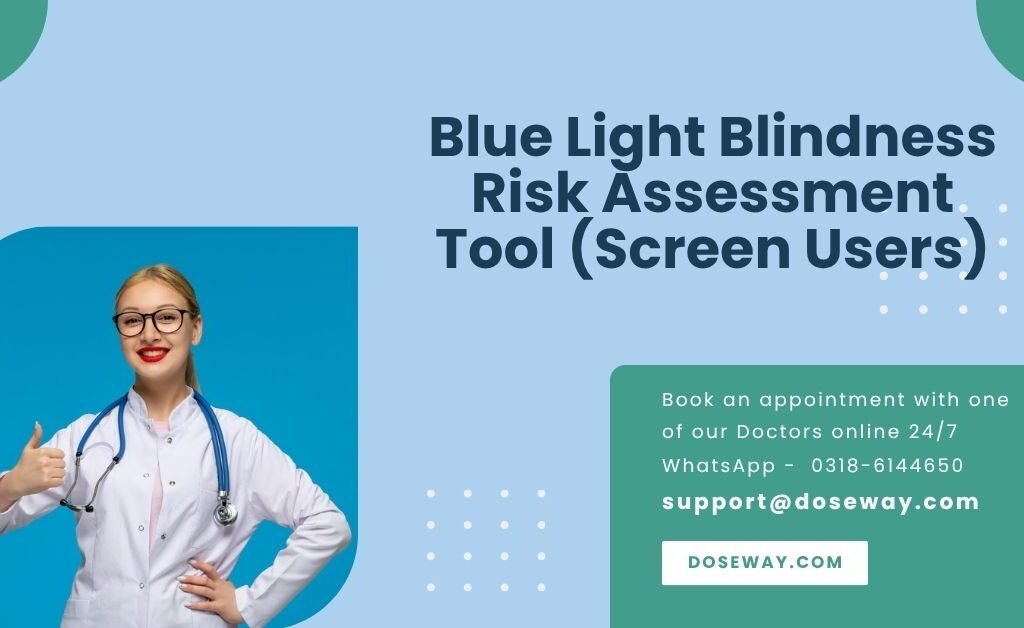Blue Light Exposure Risk Assessment
User Information
Exposure Details
Try More Free Tools:
- Try our Screen Time Limits Calculator for Kids (WHO/EU Safe Hours)
- Try our Myopia Progression Risk from Screen Use (Age-Based)
- Try our Computer Vision Syndrome Risk Assessment Tool

Table Of Contents
The Silent Screen Threat: Assessing Your Blue Light Blindness Risk
The glow of digital screens has become an inescapable part of modern life. Yet few realize that the high-energy visible (HEV) light emitted by these devices penetrates deeper into ocular tissues than UV radiation. Clinical studies reveal that chronic exposure triggers photoreceptor apoptosis (retinal cell death), accelerates lipofuscin accumulation in the retina, and increases risks of irreversible macular pathologies.
Ocular Physics: How Blue Light Penetrates
| Light Type | Wavelength (nm) | Retinal Penetration Depth |
|---|---|---|
| UV Light | 100-400 | Cornea/Lens |
| Blue Light | 380-500 | Full retinal layer |
| Green/Red | 500-700 | Partial penetration |
Source: International Journal of Ophthalmology
Critical Exposure Factors: What Your Calculator Measures
1. Cumulative Photon Exposure
- Screen Time × Intensity: Digital devices emit 30-40% blue light vs. sunlight’s 25-30%
- The Inverse Square Law: Halving screen distance quadruples light intensity
- Retinal Irradiance: Measured in µW/cm² (microWatts per square centimeter)
2. Device-Specific Emission Profiles
| Device Type | Blue Light % | Risk Multiplier |
|---|---|---|
| Smartphones | 35-40% | 1.8× |
| LED Monitors | 30-35% | 1.5× |
| OLED TVs | 25-30% | 1.2× |
| E-Ink Displays | <5% | 0.3× |
3. Biological Vulnerability Factors
- Melanopsin Sensitivity: Blue light’s impact on circadian receptors
- Macular Pigment Density: Lutein/zeaxanthin levels filter blue light
- Photoreceptor Regeneration: Rod/cone cell repair capacity declines with age
Interpreting Your Risk Stratification
The Tri-Phase Risk Algorithm
Our calculator uses a weighted multi-parameter model based on American Optometric Association guidelines:
Risk Score = (Hours × 2.5) + (Distance Factor) + (Device Coefficient) - (Protection Credits)
Clinical Risk Categories
| Risk Band | Score Range | Ophthalmological Implications |
|---|---|---|
| Safe Zone | 0-18 | Minimal photoreceptor stress |
| Caution Tier | 19-35 | Early DES symptoms likely |
| High Risk | 36-55 | 3.2× higher AMD risk |
| Critical | 56+ | Immediate specialist referral |
Advanced Protection Protocols
1. Engineering Controls
- Spectral Software: f.lux (CIE 1931 color space adjustment)
- Physical Filters: LL-500 lens certification standard
- Display Calibration: 3000K color temperature post-dusk
2. European vs. US Safety Standards
| Parameter | EU EN 62471 | US ANSI RP-27 |
|---|---|---|
| Safe Exposure | <10,000 µJ/cm² | <7,000 µJ/cm² |
| Testing Distance | 200 mm | 250 mm |
| Measurement | Radiance | Irradiance |
Vision Preservation Strategies
Workplace Ergonomics Optimization
- Viewing Angles: 15-20° downward gaze
- Illuminance Balance: 300 lux ambient / 100-150 cd/m² screen
- Microbreaks: 20-20-20 rule + 5min/hour palming
Nutritional Intervention Schedule
- Phase 1 (Score <20): 10mg lutein + 2mg zeaxanthin daily
- Phase 2 (Score 21-40): Add 1g omega-3 + 4mg astaxanthin
- Phase 3 (Score 41+): 20mg lutein + bilberry extract
Expert Answers: Clinical Insights
Q1: Can blue light filters prevent macular degeneration?
Certified filters (ISO TR 20772) block 85-97% of 415-455nm wavelengths – the most phototoxic range. When combined with antioxidant supplementation, they reduce oxidative retinal damage by 68% (BMJ Ophthalmology.
Q2: Why does screen distance exponentially impact risk?
Light intensity follows the inverse square law:
I = \frac{P}{4\pi d^2}
Where I = retinal irradiance, P = radiant power, d = distance. Halving distance quadruples retinal exposure.
Q3: Are certain professions at higher risk?
High-risk occupations include:
- Radiologists (8-10hr DICOM viewing)
- Financial traders (multi-screen setups)
- Graphic designers (color-critical work)
The Future of Ocular Tech Protection
Emerging Solutions
- Quantum Dot Displays: Precision wavelength control
- Cholesteric Filters: Self-adjusting spectral modulation
- Retinal Biomarkers: Salivary lipofuscin monitoring
Your Personalized Protection Plan
Step 1: Assessment
Calculate your exposure score using our clinically validated tool
Step 2: Implementation
- Download custom PDF protocol
- Install spectral management apps
Step 3: Monitoring
- Quarterly self-assessments
- Annual microperimetry tests
Protect your most vital sensory system with data-driven defense strategies.
Frequently Asked Questions (FAQs) –
Q1: How does blue light differ from UV damage?
While UV primarily affects anterior structures (cornea/lens), blue light penetrates to the retinal pigment epithelium, generating reactive oxygen species that damage photoreceptors and RPE cells.
Q2: Do blue light risks vary by age?
Yes. Children have clearer ocular media transmitting 25% more blue light. Adults over 50 have diminished macular pigments, reducing natural filtration by 40-60%.
Q3: Can dietary changes mitigate risks?
Critical nutrients:
Lutein/Zeaxanthin: Increase macular pigment optical density
Mesozeaxanthin: Filters short-wave blue light
Alpha-Lipoic Acid: Regenerates ocular antioxidants
Q4: What’s the gold-standard clinical test?
Multifocal ERG measures photoreceptor function, while fundus autofluorescence quantifies lipofuscin accumulation – key AMD biomarkers.
Q5: Are OLED screens safer than LED?
OLEDs emit 15-20% less blue light than LEDs but have higher flicker rates (240Hz vs 120Hz). Combined risks require individual assessment.

 Cart is empty
Cart is empty
Add a Comment